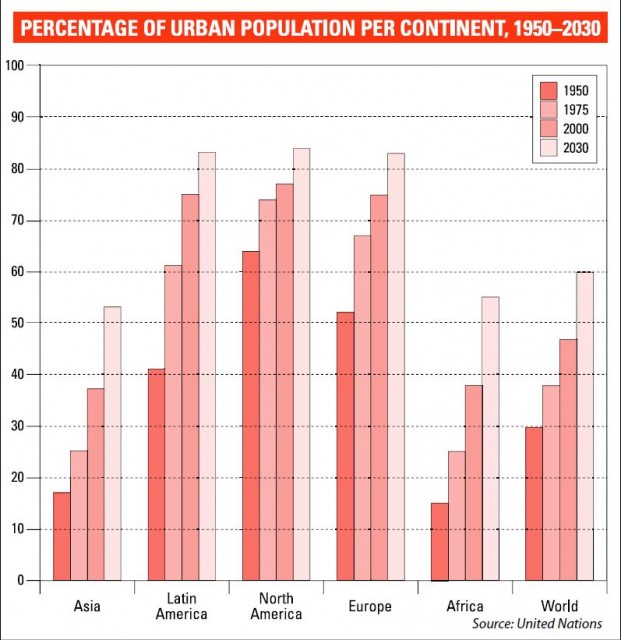Want to save the planet? Move to the city
Although it is natural to regard cities as the most unnatural and environmentally damaging places on Earth, perhaps there are two sides to this story.
Throughout history, people have voted with their feet by moving to cities. They have often faced extreme exploitation and poor living conditions to get closer to the jobs, education, crowds and culture that cities offer. In the recent past, urbanization has been gaining strength across the world. In 1950,30 percent of the world's population lived in cities, while in 2006 the total reached 50 percent. That adds up to 33 billion people.
Indeed, documents produced for the 2008 International Year of Planet Earth point out that it is not just cities that are growing, but megacities of 5 million or more people. There could be sixty of these by 2015, and they would be home to over 600 million people. Many big cities dominate their countries. In the United Kingdom (according to the 2001 census), over 7 million people were living in London and fewer than a million in Birmingham, the second city. Even that figure understates the size of London by only counting people within its boundaries as they existed some decades ago.
There are problems with urbanization and the main one is that it never knows where to stop. Many cities are so popular that they just keep growing. They tend to expand, as outer London has done in the Thames Valley, onto the flood plains of rivers. Elsewhere, avalanche-prone areas or regions with endemic subsidence get built upon, usually by the poorest inhabitants.
And although we know a lot about the social and economic advantages of cities, our knowledge of how to make them more physically friendly for their inhabitants is still underdeveloped. As the Year of Planet Earth people tactfully put it, “In the developing world, megacities grow faster than their infrastructure.They might have added that the rich world has its share of this problem too, as anyone who has tried the subway systems of Tokyo or New York at 8am knows.
Since most people want to live in one, lessening the environmental impact of cities is a top priority for reducing the effect we are having on the Earth. However, in principle, there are good reasons why urbanization might actually be beneficial for the planet. People in big cities ought to have shorter journeys to work, fun or the shops. They can be connected to electricity and fuel supplies by shorter power lines and pipes. They can get economies of scale in the raw materials they use and in the technology used to recycle or remove their leftovers. And they can use public transport. Country-dwellers in the rich world have to start every activity by gening into a car.
Of course, the fact that most people live in cities means that most people do not live in the country. The growth of both megacities and more modest urban centres means that despite population growth, there could be fewer people, not more, in rural areas in future. This itself might be a good thing for the planet.
As we have seen, most of the Earth is pretty empty. Only 30 percent of it is land, and of this, only about 10 percent is used for agriculture and another 8 percent for cattle rangeland. Take a look at Japan, which has 127 million people. Most of them live along the southern coastal strip, especially in the Tokyo megacity. Much of the country is empty, particularly the mountain chain that makes up most of the centre of Honchu, the main island.
The world already has substantial national parks and reserves. Even in the crowded UK, they add up to over 10 percent of total land area. In the past their protection has been patchy. One – Snowdonia in North Wales – contains a nuclear power station. One way of keeping the Earth in good shape would be to increase the area of it given over to such parks and reserves, in which people are scarce and go only to take a look, not to carry out primary economic activity unless it has been pre-approved by centuries of proven low-impact success.
